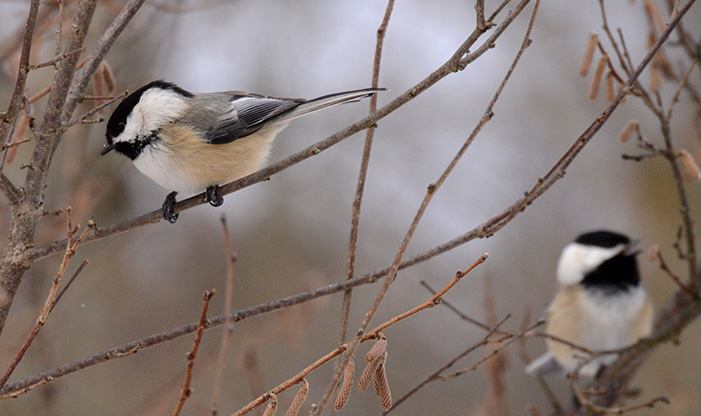Look out your backyard window, or take a walk at the Center, and you’ll likely encounter bright red male Northern Cardinals, as well as American Goldfinches, Black-capped Chickadees, and woodpeckers. Why don’t they migrate south for the winter like so many other birds? It turns out these bird species have been adapted to the climate here for a long time. They stay for one main reason: food availability.
There are survival pressures for birds wintering in Wisconsin, however. Food may be scarce at times, birds have to adapt to the weather, and there is a loss of protective cover from deciduous trees, among many other challenges. Luckily, there are ways people can help birds make it through the season.
Helping Birds Spending Winters in Wisconsin
Most birds that overwinter in Wisconsin are seed-eaters, food that is still available in winter. Birds that travel south are species that thrive on insects and food that’s prevalent in warm weather. However, even though food is available in the cold months for the birds that stay behind, they still may have challenges finding it.
The Proper Way to Feed Birds
Different types of food will attract different species. The feed itself is important. Visit a store like Wild Birds Unlimited to purchase high-quality seed, like black sunflower “oilseeds,” as well as white proso millet, cracked corn, peanuts, and thistle/nyjer. The seed should not contain filler such as red millet or flax. White proso millet will attract birds like Dark-eyed Juncos and American Tree Sparrows. Peanuts are great for Blue Jays and Northern Cardinals. Thistle/Nyjer is good for winter finches including American Goldfinches, and Pine Siskin, and Sunflower will attract White-breasted Nuthatches and Black-capped Chickadees.
Now, you just need to find the best way to deliver the seed. There are different kinds of bird feeders according to the type of seed available. One popular kind that’s also convenient to use is the tube feeder. Tube feeders do a good job at delivering seed; just remember to keep them clean and to keep the seed dry.
Another kind of bird feed is suet, which is the fat from the kidney and loin of beef cattle and sheep. Make sure the suet is real; it is usually available from pet food shops like Wild Birds Unlimited, and feed shops. If you buy it from a butcher, remove any remnants of meat and connective tissue, as they will spoil.
To use suet, place it in an onion bag or a wire screen dispenser. Birds can feed through the openings. You can also make a “Suet Log” by drilling holes into a piece of firewood, filling the holes with suet, and hanging it up. Suet can attract Downy Woodpeckers, Hairy Woodpeckers, and Red-bellied Woodpeckers.
Other Ways to Help Winter Birds
Overwintering birds can suffer for lack of protective shelter when it gets cold and wet. Birds have evolved ways to cope with the cold, like developing warm down feathers. But, with much of the leaf cover gone, they are exposed to predators as well as the elements. Consider planting native plants and trees in your yard. They’re naturally protective towards local bird species. Trees to consider include native evergreens, Red Cedar and White Cedar.
Another kind of shelter you can provide is an old Christmas tree or even a brush pile. This keeps the cold at bay and helps to keep away predators.
Birds evolved with native plants, and birds do best with plants from within their original range. Native plants work well even with the biochemistry of resident birds. For example, there are American and European versions of the highbush cranberry; local bird species prefer to eat the berries of the American highbush cranberry above the European plant.
Another essential for birds is water. They need to drink to rehydrate, and using water to keep their feathers preened is very important. The challenge is that the water freezes. Providing a heated birdbath allows birds to keep their feathers in order and get a needed drink when thirsty.
Now that you’re ready to help winter birds, the fun part is getting to know them! Feeding birds is a good way to help them; it’s also a good way to interact with them, learn more about bird species in your area, and to attract and learn about birds you might not be familiar with.
When you put out a feeder to attract birds, it creates an opportunity to start identifying them. You may begin to notice birds you hadn’t seen before. Check a field guide to see which birds come to visit you. Consider signing up for ebird and joining in citizen science while learning interesting and vital bird facts. In this way, you can help birds do well in the winter while enriching your knowledge of the avian world.


